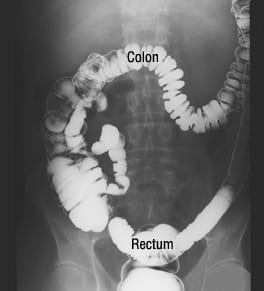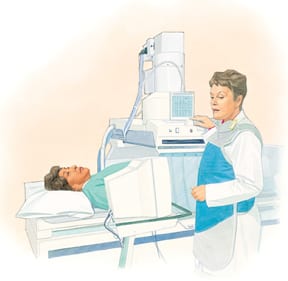Patient Basics: Barium Enema
Originally published by Harvard Health.
What Is It?
A barium enema is a procedure used to examine the lining of the colon and rectum. The procedure is also called a lower gastrointestinal series.
Barium refers to barium sulfate, a chalky chemical that appears white on X-ray film. Enema refers to any fluid pumped into the rectum through the anus. After the barium sulfate liquid makes its way to your intestines, a series of X-ray pictures are taken. In these X-rays, the white barium fluid allows some abnormalities in the lining of the intestines to appear dark. Air may be pumped into the intestine during this procedure to help sharpen the outline of the intestinal wall.
This test takes about 45 minutes. It can be done as an outpatient procedure, meaning you don’t have to stay overnight in a hospital. Although the X-rays themselves are painless, the enema may cause some slight discomfort. You may feel full or gassy.
What It’s Used For
Barium enema is sometimes used to check for tumors of the colon and rectum. It also can check for polyps (abnormal growths attached to the intestinal lining by a stalk), diverticulosis or other problems. It is rarely ordered today because other tests, such as colonoscopy and virtual colonoscopy (a type of contrast enema using a CT scanner), provide much better detail.
Preparation
Your colon and rectum need to be empty for the procedure. Your doctor will give you instructions about using laxatives and/or enemas before the procedure. Your doctor will also tell you when to stop eating and what you can drink.
How It’s Done
You will remove your clothing and put on a hospital gown. You will lie on your side on an X-ray table. A tube will be inserted into your rectum and you will be given an enema of barium fluid. As the fluid flows into your intestines, you may feel a little discomfort, pressure or the urge to move your bowels. While you hold the fluid inside your bowels, the X-ray technician will take a series of pictures. To allow the barium fluid to flow into different parts of your bowels, you will change position on the table, and the table itself may be rotated.
Once the X-rays are complete, you will go to a nearby bathroom (or be given a bedpan) to pass the barium fluid from your bowels. You will then have a second series of X-rays. This time, air is gently pumped into your rectum. This air, together with the thin film of barium fluid still in your intestines, will help to enhance the images of your intestinal lining.
Follow-Up
A radiologist will examine your X-rays and give the results to your doctor. Your doctor can then share the results with you.
To help clear the remaining barium fluid from your bowel, your doctor will give you instructions about drinking water, taking laxatives or using an enema at home. For a few days, while the barium clears, you will notice that your stools are an unusually light color.
Risks
Barium enema is a safe X-ray examination. There is a small risk of your intestines becoming blocked if the barium fluid does not clear from your bowel. This can be prevented by following your doctor’s directions for cleansing the bowel after the procedure.
When To Call a Professional
Call your doctor if you have abdominal or rectal pain, nausea, vomiting or blood in your stool after your barium enema. Call your doctor if your stools do not return to a normal color, if you have trouble moving your bowels, or if your stools become very narrow (as thin as a pencil).
Additional Info
American College of Gastroenterology (ACG)
P.O. Box 342260
Bethesda, MD 20827-2260
Phone: 301-263-9000
http://www.acg.gi.org/
American Gastroenterological Association
4930 Del Ray Ave.
Bethesda, MD 20814
Phone: 301-654-2055
Fax: 301-654-5920
http://www.gastro.org/


